Gubbins D., Herrero-Bervera E. Encyclopedia of Geomagnetism and Paleomagnetism
Подождите немного. Документ загружается.

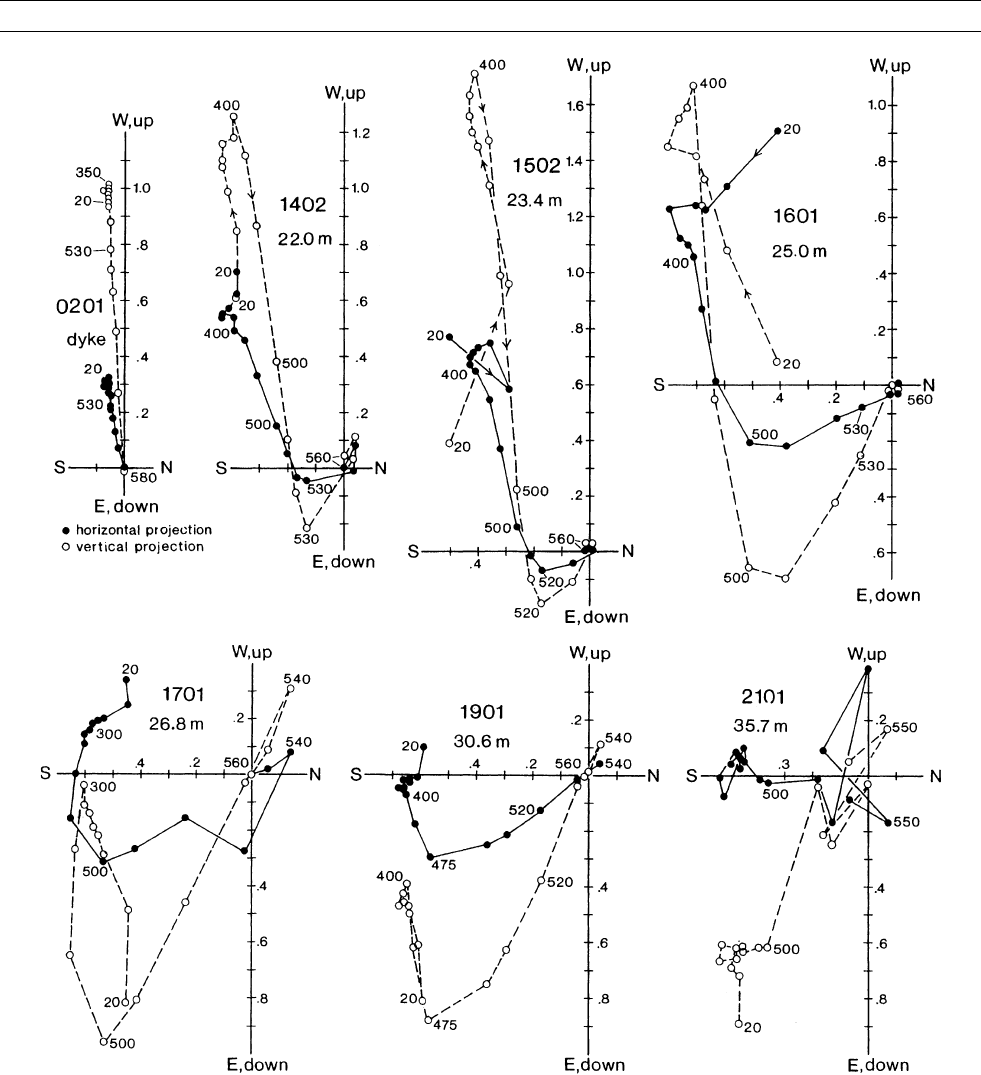
glacial perturbation (e.g., Jessop, 1971). The uncertainties involved in
estimating the paleogeothermal gradient are significant and can lead to
relatively large uncertainties in the depth of burial, even if T
amb
is well
constrained (see Schwarz et al., 1985; Hyodo et al., 1993).
Kenneth L. Buchan
Bibliography
Adam, E., 1990. Temperature ambiante de la roche hôte deduite de
l’histoire thermique d’un dyke: apport du paleomagnetisme.
B.Eng. thesis, École Polytechnique, Montreal: Université de
Montréal, 62 pp.
Figure M124 Orthogonal component plots showing thermal demagnetization results for selected samples from the Indin dike profile of
Figure M122 (after Schwarz et al., 1985). Peak temperatures are indicated in degree Celsius. Closed and open symbols indicate
projections onto the horizontal and N-S vertical planes, respectively.
606 MAGNETIZATION, REMANENT, AMBIENT TEMPERATURE AND BURIAL DEPTH FROM DYKE CONTACT ZONES

Buchan, K.L., and Schwarz, E.J., 1981. Uplift estimated from rema-
nent magnetization: Munro area of Superior Province since 2150
Ma. Canadian Journal of Earth Sciences, 18: 1164–1173.
Buchan, K.L., and Schwarz, E.J., 1987. Determination of the maxi-
mum temperature profile across dyke contacts using remanent
magnetization and its application. In Halls, H.C., and Fahrig, W.F.,
(eds.), Mafic Dyke Swarms. Geological Association of Canada
Special Paper 34, pp. 221–227.
Buchan, K.L., Schwarz, E.J., Symons, D.T.A., and Stupavsky, M.,
1980. Remanent magnetization in the contact zone between
Columbia Plateau flows and feeder dykes: evidence for ground-
water layer at time of intrusion. Journal of Geophysical Research,
85: 1888–1898.
Carslaw, H.S., and Jaeger, J.C., 1959. Conduction of Heat in Solids,
2nd edn. New York: Oxford University Press, 510 pp.
Delaney, P.T., 1982. Rapid intrusion of magma into wet rock: ground-
water flow due to pore pressure increases. Journal of Geophysical
Research, 87: 7739–7756.
Delaney, P.T., 1987. Heat transfer during emplacement and cooling of
mafic dykes. In Halls, H.C., and Fahrig, W.F. (eds.), Mafic Dyke
Swarms. Geological Association of Canada Special Paper 34, pp.
31–46.
Delaney, P.T., 1988. Fortran 77 programs for conductive cooling of
dikes with temperature-dependent thermal properties and heat of
crystallization. Computers and Geosciences, 14: 181–212.
Delaney, P.T., and Pollard, D.D., 1982. Solidification of basaltic
magma during flow in a dike. American Journal of Science, 282:
856–885.
Dodson, M.H., 1973. Closure temperature in cooling geochronological
and petrological systems. Contributions to Mineralogy and Petrol-
ogy, 40: 259–274.
Dunlop, D.J., 1979. On the use of Zijderveld vector diagrams in
multicomponent paleomagnetic studies. Physics of the Earth and
Planetary Interiors, 20:12–24.
Dunlop, D.J., and Özdemir, Ö., 1997. Rock magnetism: fundamen-
tals and frontiers. Cambridge: Cambridge University Press,
573 pp.
Halls, H.C., 1986. Paleomagnetism, structure and longitudinal correla-
tion of Middle Precambrian dykes from northwest Ontario and
Minnesota. Canadian Journal of Earth Sciences, 23: 142–157.
Hyodo, H., York, D., and Dunlop, D., 1993. Tectonothermal history in
the Mattawa area, Ontario, Canada, deduced from paleomagnetism
and
40
Ar/
39
Ar dating of a Grenville dike. Journal of Geophysical
Research, 98: 18001–18010.
Jaeger, J.C., 1964. Thermal effects of intrusions. Reviews of Geophy-
sics, 2(3): 711–716.
Jessop, A.M., 1971. The distribution of glacial perturbation of heat
flow. Canadian Journal of Earth Sciences, 8: 162–166.
Jessop, A.M., and Lewis, T., 1978. Heat flow and heat generation in
the Superior Province of the Canadian Shield. Tectonophysics,
50:55–77.
McClelland Brown, E., 1981. Paleomagnetic estimates of temperatures
reached in contact metamorphism. Geology, 9:112– 116.
McClelland Brown, E., 1982. Discrimination of TRM and CRM by
blocking-temperature spectrum analysis. Physics of the Earth and
Planetary Interiors, 30: 405–411.
Nagata, T., 1961. Rock Magnetism. Tokyo, Japan: Maruzen Company
Ltd., 350 pp.
Oveisy, M.M., 1998. Rapakivi granite and basic dykes in the Fennos-
candian Shield: a palaeomagnetic analysis, PhD thesis, Luleå,
Sweden: Luleå University of Technology.
Pullaiah, G., Irving, E., Buchan, K.L., and Dunlop, D.J., 1975. Magne-
tization changes caused by burial and uplift. Earth and Planetary
Science Letters, 28: 133–143.
Schwarz, E.J., 1976. Vertical motion of the Precambrian Shield from
magnetic overprinting. Bulletin of the Canadian Association of
Physicists, 32:3.
Schwarz, E.J., 1977. Depth of burial from remanent magnetization: the
Sudbury Irruptive at the time of diabase intrusion (1250 Ma).
Canadian Journal of Earth Sciences, 14:82–88.
Schwarz, E.J., and Buchan, K.L., 1982. Uplift deduced from remanent
magnetization: Sudbury area since 1250 Ma ago. Earth and Plane-
tary Science Letters, 58:65–74.
Schwarz, E.J., and Buchan, K.L., 1989. Identifying types of remanent
magnetization in igneous contact zones. Physics of the Earth and
Planetary Interiors, 68: 155–162.
Schwarz, E.J., Buchan, K.L., and Cazavant, A., 1985. Post-Aphebian
uplift deduced from remanent magnetization, Yellowknife area
of Slave Province. Canadian Journal of Earth Sciences
, 22:
1793–1802.
Symons, D.T.A., Hutcheson, H.I., and Stupavsky, M., 1980. Positive
test of the paleomagnetic method for estimating burial depth
using a dike contact. Canadian Journal of Earth Sciences, 17:
690–697.
Touloukian, Y.S., Judd, W.R., and Roy, R.F., (eds.), 1981. Physical
Properties of Rocks and Minerals. New York: McGraw-Hill,
548 pp.
Cross-reference
Baked Contact Test
MAGNETIZATION, REMANENT, FOLD TEST
Establishing the age of the remanence acquisition with respect to the
origin of the rock unit or age of structural deformation events is critical
in the interpretation of paleomagnetic data. It is also important to
establish that the magnetic minerals carry a stable magnetization over
geological timescales. These two related questions remain difficult
problems, which often affect the application of paleomagnetism to tec-
tonic, stratigraphic, and paleogeographic problems (Cox and Doell,
1960; Irving, 1964). It is therefore not surprising that early in the
development of the paleomagnetic method, several field and labora-
tory tests were developed and applied to a range of geological con-
texts. Among them, an elegant simple answer was put forward to
constrain the age of remanence acquisition by using field information
by Graham (1949). He realized that in folded rocks a simple test based
on rotation of the magnetization directions about the local strike could
determine if the remanence was acquired before the deformation event
—if magnetization directions were dispersed in present-day coordi-
nates and clustered upon tilt rotation (Figure M125a). Magnetization
directions that cluster in present-day coordinates and disperse upon tilt
rotation indicate that remanence acquisition occurred after the defor-
mation event (Figure M125b). At the time Graham (1949) developed
this test, the multivectorial nature of natural remanent magneti-
zation (NRM) had not been properly recognized, and the demagnetiza-
tion techniques for isolating remanent components had not been
developed. The fold test nevertheless worked well as applied to the
deformed sedimentary strata of the Rose Hill Formation from Maryland,
mainly because the NRMs are univectorial and the strata are tilted
to large angles without major structural complexities (French and
Van der Voo, 1979). The Graham fold test can be applied to study
single deformed structures, including a fold within an undeformed
sequence, or over wide deformed areas with sampling at sites with
varying bedding tilts.
The impact of paleomagnetic data in the study of regional tectonic
processes, particularly in the establishment of the continental drift
theory, and the increasing use of demagnetization and statistical
techniques in investigating multi-vectorial remanences made the use
of field tests fundamental tools for paleomagnetists (Irving, 1964;
McElhinny, 1973). Field tests to investigate the magnetization stability
and the timing and mode of remanent magnetization acquisition include
MAGNETIZATION, REMANENT, FOLD TEST 607
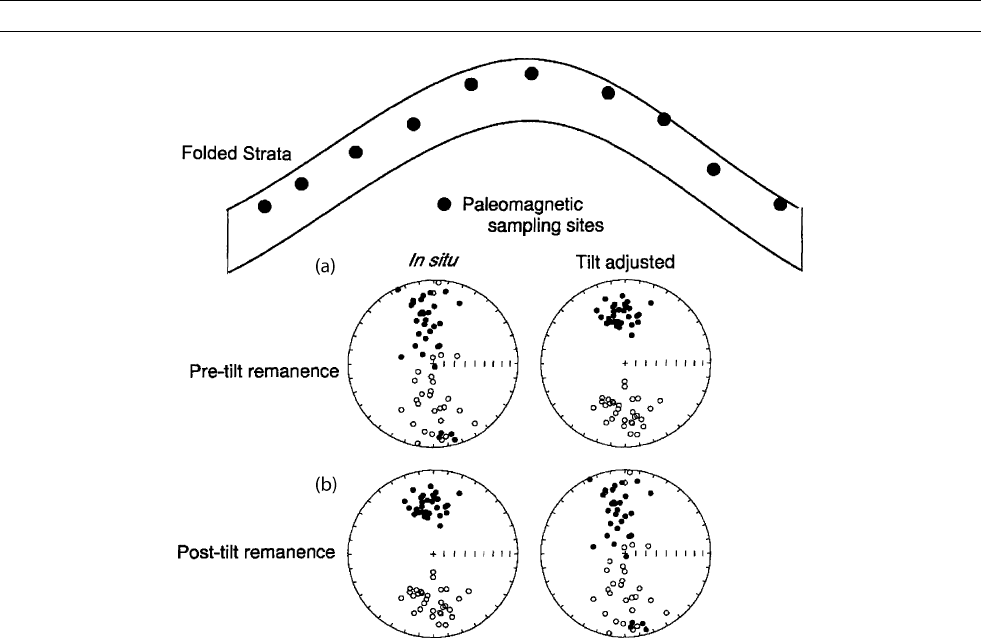
the (a) fold test, (b) conglomerate test, (c) baked contact test, (d) rever-
sal test, and (e) consistency test. Looking at the many applications
developed over the years can easily assess the importance of the field
tests in paleomagnetic research.
Development of the fold test in paleomagnetism has involved incor-
poration of statistical criteria to evaluate the significance of the test,
advances in separating multicomponent magnetizations, advances in
paleomagnetic instrumentation providing more sensitive instrumenta-
tion and methods to measure weak magnetizations, and application
to a wide range of deformed rock units as well as local and regional
tectonic structures.
Statistical criteria
Application of statistical criteria in evaluating the test significance was
first attempted by McElhinny (1964), by using the concentration para-
meter k of the Fisher (1953) statistics to distinguish between pre- and
postfolding magnetization data sets. The criterion is an application of
the statistical test for comparing the precisions using the Fisherian con-
centration parameter of two separate groups of sample directions with
the precision of unfolded directions (k
a
) compared with the precision
for in situ directions (k
b
). The ratio k
a
/k
b
is referred to F-ratio tables
at given confidence limits and with equal degrees of freedom
(2N 1), where N is the number of sample directions studied.
The application of statistical criteria permitted the use of the fold
test in a wide range of deformed structures, and McElhinny (1964)
fold test is still used in paleomagnetic studies. The test is applied in
spite of the problem noticed by McFadden and Jones (1981) that the
use of Fisher statistics for directional data sets, which are not Fisher
distributed, is not valid. This occurs either way if magnetizations are
pre- or postfolding. For instance, if directions are Fisher distributed
in in situ coordinates, then they are not tilt-corrected coordinates.
McFadden and Jones (1981) proposed a test based on comparison of
Fisher distributed data sets derived from opposite limbs of a fold in
in situ and tilt-corrected coordinates. The new test again implies no
internal distortion of magnetization and more intensive field sampling,
but it can be applied under less stringent conditions than the McElhinny
(1964) test.
Two further statistical significance tests based on comparison of dis-
tributions of magnetization directions, which require less demanding
sampling strategies than the test by McFadden and Jones (1981), have
been proposed by McFadden (1990) and Bazhenov and Shipunov
(1991). The test of Bazhenov and Shipunov (1991) considers different
structural attitudes by making division of bedding plane data into
groups, which gives greater flexibility in the sampling strategy. Never-
theless, the tests have been little used in paleomagnetic studies mainly
because their statistical significance is relatively weak (e.g., Weil and
Van der Voo, 2002).
Evaluation of fold test data sets has also been examined in terms of
a parameter estimation problem, by applying simple bootstrap or
Monte Carlo approaches. In these tests, large numbers of sample data
are generated to determine confidence limits and significance of the
maximum clustered directional distribution (Fisher and Hall, 1990;
Tauxe et al., 1991; Watson and Enkin, 1993; Tauxe and Watson,
1994). Tauxe and Watson (1994) developed a test using eigen analysis
of directional data sets that estimates the degree to which directions
from different structural attitude sites are parallel. In this way, direc-
tional data sets do not need to conform to a Fisher distribution, and
confidence limits are derived from bootstrap and parametric bootstrap
techniques according to data set size.
McFadden (1998) discussed the underlying assumption of para-
metric estimation fold tests that the magnetization directions show
maximum clustering with the strata in the position magnetization
was acquired. This is not the case when folding does not conform to
Figure M125 Paleomagnetic fold test.
608 MAGNETIZATION, REMANENT, FOLD TEST

simple cylindrical horizontal axis geometry and additional factors are
involved like plunging folds, unaccounted overprints, etc.
Jaime Urrutia-Fucugauchi
Bibliography
Bazhenov, M.L., and Shipunov, S.V., 1991. Fold test in paleomagnet-
ism: new approaches and reappraisal of data. Earth and Planetary
Science Letters, 104:16–24.
Chan, L.S., 1988. Apparent tectonic rotations, declination anomaly
equations, and declination anomaly charts. Journal of Geophysical
Research, 93: 12151–12158.
Cogné, J.P., and Perroud, H., 1985. Strain removal applied to paleo-
magnetic directions in an orogenic belt; the Permian red slates of
the Alpes Maritimes, France. Earth and Planetary Science Letters,
72: 125–140.
Cox, A., and Doell, R.R., 1960. Review of paleomagnetism. Bulletin
of the Geological Society of America, 71: 647–768.
Facer, R.A., 1983. Folding, Graham’s fold tests in paleomagnetic
investigations. Geophysical Journal of the Royal Astronomical
Society, 72: 165–171.
Fisher, N.I., and Hall, P., 1990. New statistical methods for directional
data—I. Bootstrap comparison of mean directions and the fold
test in paleomagnetism. Geophysical Journal International, 101:
305–313.
Fisher, R.A., 1953. Dispersion on a sphere. Proceedings of the Royal
Society of London Series A, 217: 295–305.
French, A.N., and Van der Voo, R., 1979. The magnetization of the
Rose Hill Formation at the classic site of Graham’s fold test. Jour-
nal of Geophysical Research, 48: 7688–7696.
Graham, J.W., 1949. The stability and significance of magnetism in
sedimentary rocks. Journal of Geophysical Research, 54: 131–167.
Irving, E., 1964. Paleomagnetism and Its Application to Geological
and Geophysical Problems. New York: Wiley.
Kodama, K.P., 1988. Remanence rotation due to rock strain during
folding and the stepwise application of the fold test. Journal of
Geophysical Research, 93: 3357–3371.
MacDonald, W.D., 1980. Net rotation, apparent tectonic rotation, and
the structural tilt correction in paleomagnetic studies. Journal of
Geophysical Research
, 85: 3659–3669.
McElhinny, M.W., 1964. Statistical significance of the fold test in
palaeomagnetism. Geophysical Journal of the Royal Astronomical
Society, 8: 338–340.
McElhinny, M.W., 1973. Paleomagnetism and Plate Tectonics. Cam-
bridge Earth Science Series, Cambridge University Press, 358 pp.
McFadden, P.L., 1990. A new fold test for paleomagnetic studies.
Geophysical Journal International, 103: 163–169.
McFadden, P.L., 1998. The fold test as an analytical tool. Geophysical
Journal International, 135: 329–338.
McFadden, P.L., and Jones, D.L., 1981. The fold test in paleomagnet-
ism. Geophysical Journal of the Royal Astronomical Society, 67:
53–58.
Stamatakos, J., and Kodama, K.P., 1991a. Flexural flow folding and
the paleomagnetic fold test: an example of strain reorientation of
remanence in the Mauch Chunk Formation. Tectonics, 10: 807–819.
Stamatakos, J., and Kodama, K.P., 1991b. The effects of grain-scale
deformation on the Bloomsburg Formation pole. Journal of Geo-
physical Research, 96: 17919–17933.
Stewart, S., 1995. Paleomagnetic analysis of plunging fold structures:
errors and a simple fold test. Earth and Planetary Science Letters,
130:57–67.
Tauxe, L., and Watson, G.S., 1994. The fold test: an eigen analysis
approach. Earth and Planetary Science Letters, 122: 331–341.
Tauxe, L., Kylstra, N., and Constable, C., 1991. Bootstrap statistics
for paleomagnetic data. Journal of Geophysical Research, 96:
11723–11740.
Van der Plujim, B.A., 1987. Grain-scale deformation and fold test-
evaluation of syn-folding remagnetization. Geophysical Research
Letters, 14: 155–157.
Watson, G.S., and Enkin, R.J., 1993. The fold test in paleomagnetism
as a parameter estimation problem. Geophysical Research Letters,
20: 2135–2137.
Weil, A.B., and Van der Voo, R., 2002. The evolution of the paleomag-
netic fold test as applied to complex geologic situations, illustrated
by a case study from northern Spain. Physics and Chemistry of the
Earth, 27: 1223–1235.
MAGNETIZATION, THERMOREMANENT
Introduction
Thermoremanent magnetization (TRM) is acquired when magnetic
minerals cool in a weak magnetic field H from above their Curie tem-
peratures. TRM is the most important remanent magnetization used in
paleomagnetism. It is almost always close to parallel to the field which
produced it, and its intensity is proportional to the strength of the field
for weak fields like the Earth’s. The TRM of rocks is therefore a vast
storehouse of recorded information about past movements of the
Earth’s lithospheric plates and the history of the geomagnetic field.
The primary natural remanent magnetization of an igneous rock or a
high-grade metamorphic rock is a TRM. Newly erupted seafloor lavas
at mid-ocean ridges acquire an intense TRM on cooling below the
Curie temperature T
C
. Rapid cooling also results in fine grain size,
which makes the TRM highly stable, so that oceanic basalts are excel-
lent recorders of the paleomagnetic field. However, the TRM is largely
replaced within at most a million years of formation by chemical
remanent magnetization (CRM) of reduced intensity.
The magnetic signal recorded in archeological materials such as pot-
tery, bricks, and the walls and floors of the ovens in which they were
fired at high temperature is also a pure TRM residing in single-domain
(SD) and pseudosingle-domain (PSD) grains. These materials should
be ideal for determinations of the paleointensity of the Earth’s field
at the time of firing because they are strongly magnetized and the
minerals have been stabilized physically and chemically well above
their Curie temperatures before their initial cooling.
TRM results from thermally excited changes in magnetization.
In the case of SD grains, it is a frozen high-temperature equilibrium
distribution between two microstates in which the spins of all
atoms are either parallel or antiparallel to an applied field H. At tem-
peratures below T
C
, there are large perturbations of a crystal’s spin
structure, leading to transitions between structures of different types.
With cooling, transitions become more difficult, as evidenced by a
rapidly increasing relaxation time t. Eventually, decreasing thermal
energy and increasing energy barriers E
B
between states prevent
further transitions and TRM is frozen in very abruptly at a blocking
temperature T
B
.
The TRM of multidomain (MD) grains results from the blocking of
domain walls at positions determined by the externally applied field H,
the internal demagnetizing field H
D
of the grain, and the pinning effect
of lattice defects.
Theories of TRM and reviews of experimental data have been given
by Néel (1949, 1955), Everitt (1961, 1962), Stacey (1958), Schmidt
(1973), Day (1977), and Dunlop and Özdemir (1997).
Relaxation time and single-domain TRM
Néel’s (1949, 1955) theory of relaxation time deals with noninter-
acting uniaxial SD grains with saturation magnetization M
S
and
volume V. M
S
results from the parallel exchange coupling of atomic
spins and is a strong function of temperature T near T
C
, but is weakly
dependent on T at low temperatures. Néel’s SD theory makes use of
MAGNETIZATION, THERMOREMANENT 609
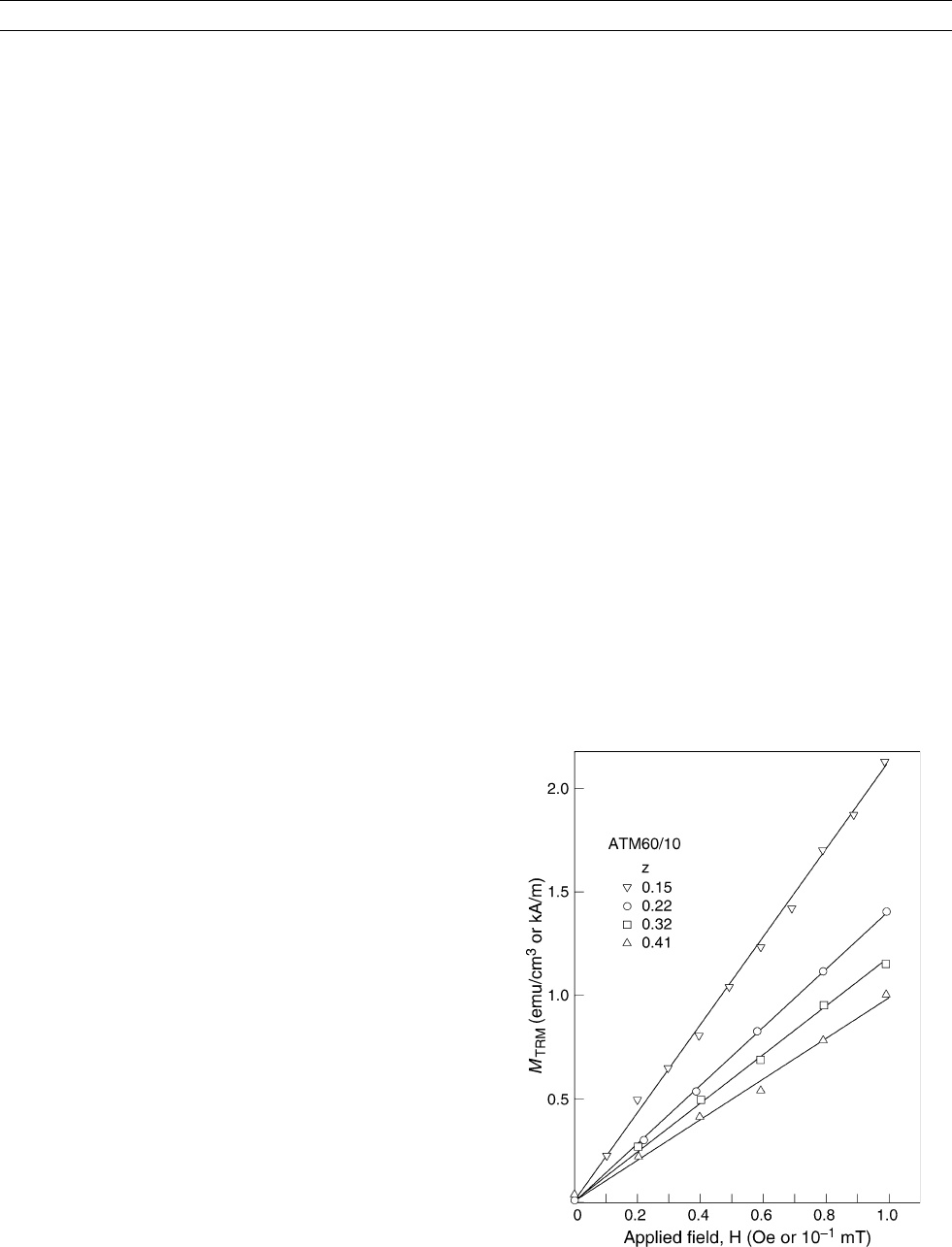
Stoner and Wohlfarth’s (1948) results for coherent rotation in spheroi-
dal SD grains aligned with a weak field H. The magnetic moment
VM
S
has a choice of orientations controlled by the easy axes of aniso-
tropy. Uniaxial shape anisotropy is dominant in minerals such as mag-
netite with high M
S
. Shape anisotropy produces two energy minima,
corresponding to spins in one or the other direction along the longest
axis of the grain. These two minima define the two SD microstates.
At 0 K, spins would be exchange coupled exactly parallel; but at
ordinary temperatures, thermal excitations perturb the spin lattice,
resulting in a steady decrease in M
S
(T ). At high temperatures, rever-
sals of grain moments are also excited as M
S
(T ) drops rapidly toward
zero at T
C
.
At ordinary temperatures, spontaneous reversals of an SD grain are
unlikely because the energy barrier between microstates due to shape
anisotropy is much larger than the available thermal energy (25kT
for experimental times of a few minutes, where k is Boltzmann’s
constant). Close to T
C
, where E
B
is small, the energy barrier becomes
comparable to 25kT and SD moments can reverse with the help of
thermal excitations. This thermally excited condition is called super-
paramagnetism. The transition from a superparamagnetic state to
a stable magnetic state is quite sharp and defines the blocking
temperature T
B
.
At any time, SD particles are either in state 1, in which moments are
aligned with H, or state 2, in which moments are antiparallel to H. The
transition probability set by the energy barrier DE
B
between states
leads to a relaxation time for exponential magnetization decay
1=t ¼1=t
0
expðE
B
=kTÞ¼1=t
0
exp½ðm
0
VM
S
H
K
=2kTÞ
ð1H=H
K
Þ
2
(Eq: 1)
where t
0
¼ 10
9
–10
10
s is the atomic reorganization time for transi-
tions between microstates and microcoercivity H
K
¼ (N
b
N
a
)M
S
for
shape anisotropy. N
a
and N
b
are the demagnetizing factors when M
S
is
directed parallel or perpendicular, respectively, to the long axis. The
thermally activated transitions between states 1 and 2 cause the aver-
age moment of a grain ensemble to relax to a thermal equilibrium
value
MðtÞ¼M ð0Þexpðt=tÞþMð1Þ½1 expðt=tÞ: (Eq. 2)
The thermal equilibrium magnetization above and at the blocking tem-
perature T
B
is
M
eq
¼ M ð1Þ ¼ M
S
tanhðm
0
VM
S
H=kT Þ: (Eq. 3)
The dependence of t on temperature by Eq. (1) is very significant.
As T decreases, the energy barriers increase and t grows exponentially,
changing from a few seconds to millions of years over a narrow
temperature interval. This rapid change leads to the concept of the
blocking temperature at which t ¼ t (experimental time).
T
B
¼½m
0
VM
SB
H
KB
=2k lnðt=t
0
Þð1 H=H
KB
Þ
2
; (Eq. 4)
where M
SB
and H
KB
are the values of M
S
and H
K
at the blocking tem-
perature.
Equation (1) also predicts a strong dependence of t on grain size.
SD grains only slightly above superparamagnetic size have relaxation
times greater than the age of the earth, but relaxation times of only a
few minutes at T
B
of a few hundred degrees Celsius.
Thus, on cooling below T
B
in an applied field, all of the orientations
of the SD moments remain fixed as their M
S
increases and TRM is
frozen in:
M
TRM
¼ M
RS
ðTÞtanh m
0
VM
SB
H=kT
B
ðÞ; (Eq. 5)
where M
RS
is the saturation value of TRM. Single-domain M
TRM
should be relatively intense because tanh(a) saturates rapidly as
a ¼ m
0
VM
SB
H/kT
B
increases and TRM then approaches the SD satura-
tion remanence M
RS
.
The high thermal stability of TRM is also accounted for, because
M
TRM
can only be unfrozen and reset to zero by reheating to the
unblocking temperature T
UB
in H ¼ 0. According to Eq. (4),ifH
H
K
, then T
UB
T
B
. TRM can only be demagnetized by reheating to
its original high blocking temperature.
Experimental single-domain TRM
According to Eq. (5), the intensity of weak-field TRM is
proportional to the applied field strength H, since tanh(a) / a
for small a. The proportionality between M
TRM
and H in weak
fields (Figure M126) has been verified by measuring TRM
acquisition curves in the weak-field region for synthetic oxidized SD
titanomagnetites Fe
2.3
Al
0.1
Ti
0.6
O
4
over a range of oxidation para-
meters 0.15 < z < 0.41 (Özdemir and O’Reilly, 1982). Figure M126
also shows a decrease in the intensity of TRM with increasing degree
of maghemitization. This fall in intensity is about the same as that
reported to take place in submarine basalts with increasing distance
from mid-ocean ridges.
Although Eq. (5) gives a reasonable match to observed absolute
TRM intensity in the weak-field region, the Néel SD theory is less suc-
cessful in explaining TRM acquisition for higher fields, H 01Oe
or 0.1 mT. The TRM intensity predicted by Eq. (5) reaches saturation
at quite low fields. Experimentally, SD TRM usually saturates in
much larger fields, on the order of 100 Oe or 10 mT (Figure M127).
This discrepancy has been attributed to either angular dispersion of
particle axes (Stacey and Banerjee, 1974) or particle interactions.
Dunlop and West (1969) modified Eq. (5) by introducing an interac-
tion field distribution that was estimated from experimental Preisach
diagrams.
Figure M126 The acquisition of TRM in weak fields for single
domain titanomaghemites with composition Fe
2.5
Al
0.1
Ti
0.4
O
4
(ATM/60). TRMs are linear with H and decrease with increasing
oxidation parameter z (after O
¨
zdemir and O’Reilly, 1982).
610 MAGNETIZATION, THERMOREMANENT
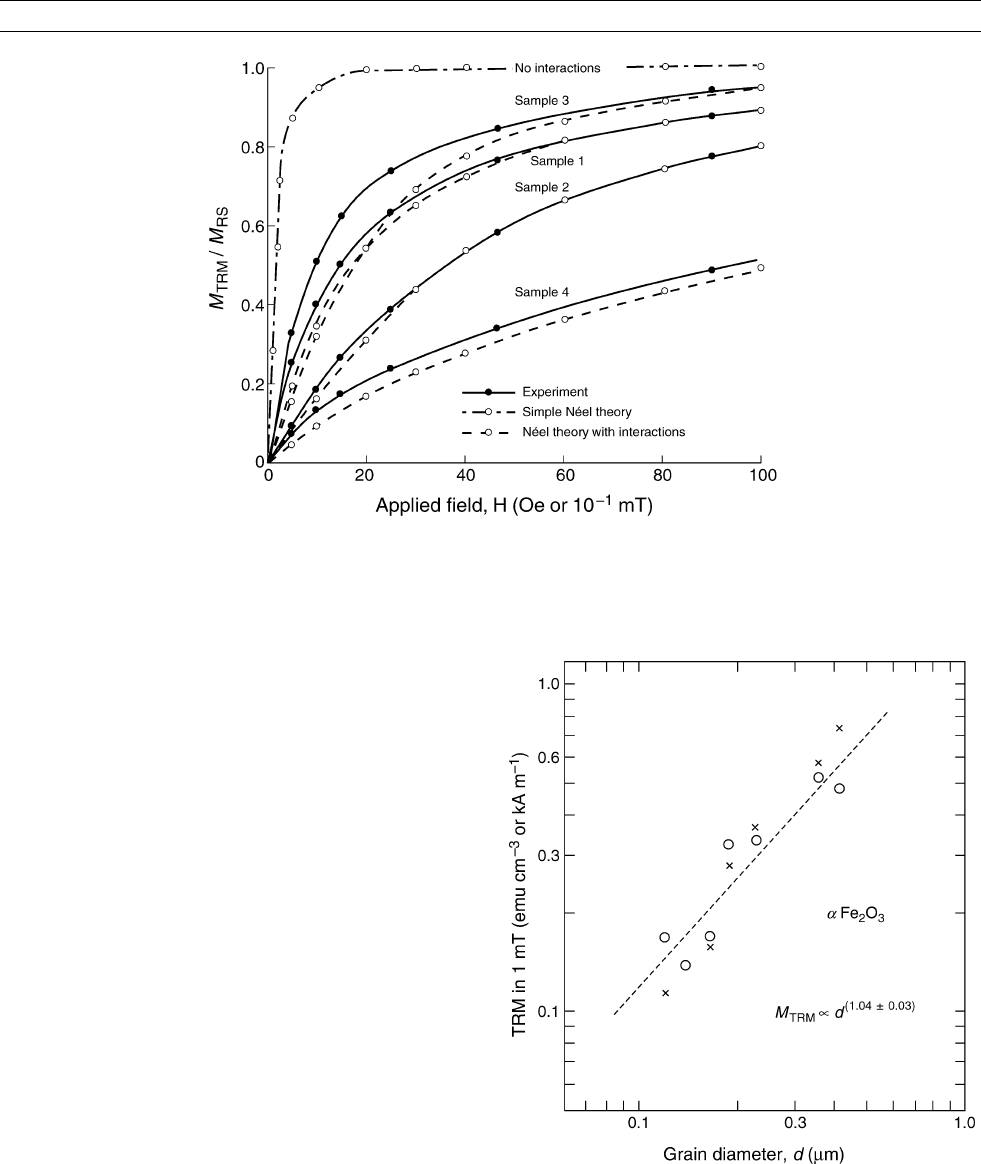
TRM intensity varies strongly with grain size d. Eq. (5) predicts an
increase in M
TRM
in proportion to increasing grain volume V. Figure
M128 shows the grain-size dependence of TRM intensity for SD
hematites. M
TRM
increases in almost exact proportion to grain size d,
not d
3
. A similar dependence is observed for magnetite grains smaller
than the critical SD size d
0
0.1 mm, the threshold between SD and non-
SD states (Figure M129). Above d
0
, M
TRM
decreases with increasing
grain size, as d
–1
below 1 mmandasd
–0.55
above 1 mm. Thus, the Néel
SD theory does not explain experimental TRM data for magnetite over
most of its natural grain-size range. However, Néel’s SD theory is more
relevant to TRM in SD hematites because hematite has a small M
S
(2
kA m
–1
)andalarged
0
.
One of the important properties of SD TRM is the equality of the
blocking temperature T
B
during field cooling and the unblocking
temperature T
UB
during zero-field reheating. Experimentally, as in
Figure M126, and theoretically according to Eq. (5), the intensity of a
weak-field TRM, and the intensities of all the partial TRMs with differ-
ent T
B
values that compose it, are proportional to the applied field
strength. The equality of T
B
and T
UB
for weak fields and the proportion-
ality of TRM and pTRM intensities to field H form the basis for deter-
mining paleofield intensity by the Thellier and Thellier (1959) method.
Field dependence of blocking temperature has been examined
by Sugiura (1980) and Clauter and Schmidt (1981). T
B
(H)as
predicted by Eq. (4) has been verified directly by measuring pTRMs
covering the entire blocking-temperature spectrum for SD magnetites.
Sugiura (1980) obtained a close match of theoretical and experimental
T
B
spectra by assuming a single value of V and subdividing the
H
K
spectrum into 11 fractions (Figure M130). The blocking-tempera-
ture spectrum shifts to lower temperature as H increases. Unblocking
temperatures during zero-field heating are therefore always higher than
blocking temperatures observed during in-field cooling (Dunlop and
West, 1969).
Equation (4) predicts that blocking and unblocking temperatures
vary with grain volume V. Experimentally determined blocking tem-
peratures (Dunlop, 1973) agree well with the theoretical blocking
temperatures calculated with a 3D micromagnetic model (Winklhofer
et al., 1997). Small SD grains have lower blocking and unblocking
temperatures than large SD grains. The predicted quadratic depen-
dence of T
B
on the applied field is confirmed experimentally.
The dependence of TRM intensity on the rate of cooling is of prac-
tical interest to paleomagnetists studying slowly cooled orogens.
Figure M127 Experimental TRM acquisition curves for a number of synthetic magnetites with mean grain sizes from 0.04 to 0.22 mm
compared to the prediction of Ne
´
el’s (1949) theory of noninteracting SD grains. The theory cannot explain the rapid initial rise of the
experimental curves combined with their gradual approach to saturation (after Dunlop and West, 1969).
Figure M128 Grain-size dependence of TRM intensity for the
single-domain hematites. The dashed line has slope 1.04 showing
that M
TRM
is very nearly proportional to d . Open circles:
experimental data points; crosses: theoretical TRM values from
Ne
´
el (1949) SD theory (after O
¨
zdemir and Dunlop, 2002).
MAGNETIZATION, THERMOREMANENT 611
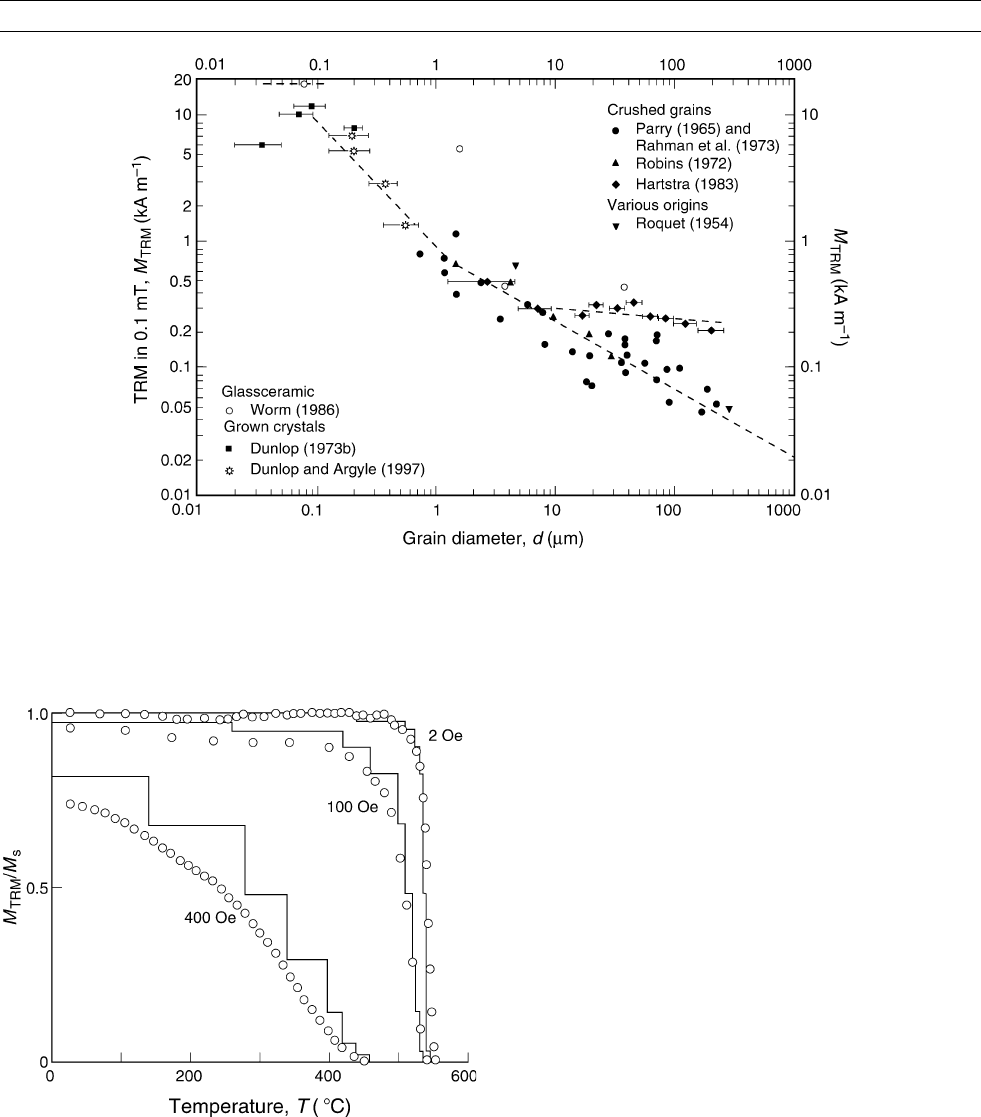
Dodson and McClelland-Brown (1980) and Halgedahl et al. (1980)
predicted that the intensity of TRM in SD grains should increase for
longer cooling times, possibly by as much as 40% between laboratory
and geological settings. Experiments by Fox and Aitken (1980) for
baked clay samples containing SD magnetites showed that there was
about a 7% decrease in the intensity of TRM when the cooling time
changed from 2.5 h to 3 min.
Partial TRM and paleofield intensity determination
According to Eq. (4), T
B
depends on grain volume V and microscopic
coercivity H
K
. Any real rock has a distribution f (V, H
K
) of both V and
H
K
, and as a result will have a spectrum of blocking temperatures.
Therefore, the total TRM of a rock will consist of a spectrum of partial
TRMs, each carried by grains with similar (V, H
K
). When a rock cools
from T
1
to T
2
in a field H, SD ensembles with T
2
T
B
T
1
pass from
the unblocked to the blocked condition, acquiring a partial TRM,
M
PTRM
(T
1
, T
2
, H).
Thellier (1938) showed that SD partial TRMs follow experimental
laws of additivity, reciprocity, and independence. Independence: Par-
tial TRMs acquired in different temperature intervals are mutually
independent in direction and intensity. Each partial TRM disappears
over its own blocking-temperature interval. Additivity: Partial TRMs
produced by the same H have intensities that are additive. This is
expected theoretically because the blocking-temperature spectrum can
be decomposed into nonoverlapping fractions, each associated with
one of the partial TRMs. The total TRM is the sum of partial TRMs cov-
ering the entire blocking-temperature interval from T
C
to room tempera-
ture because each partial TRM contains a unique part of the T
B
spectrum
of the total TRM. Reciprocity: The partial TRM acquired between T
1
and T
2
during cooling in H is thermally demagnetized over the interval
(T
2
, T
1
) when heated in zero field. In other words, the blocking and
unblocking temperatures are identical for weak fields.
Since partial TRM acquired at T
B
during cooling is erased at T
B
dur-
ing heating, one can replace the natural remanent magnetization
(NRM) M
NRM
of a rock in a stepwise fashion with a laboratory
TRM. This is done in practice by a series of double heatings, the first
in zero field and the second in a known laboratory field H
LAB
. If the
NRM of a rock was acquired as a TRM in an ancient geomagnetic
field H
A
, M
NRM
should be proportional to H
A
. The intensity of the
ancient geomagnetic field is then given by
H
A
¼ M
NRM
H
LAB
=M
TRM
;
Figure M129 Weak-field TRM as a function of magnetite grain size d. M
TRM
decreases approximately as d
–1
between 0.1 and
1 mm and less strongly as d
–0.55
above 1 mm (after Dunlop and Argyle, 1997).
Figure M130 Continuous cumulative TRM spectra measured
during cooling of single domain magnetite (points and solid
curves) compared with theoretical stepwise spectra for H ¼ 2,
100, and 400 Oe (after Sugiura, 1980).
612 MAGNETIZATION, THERMOREMANENT
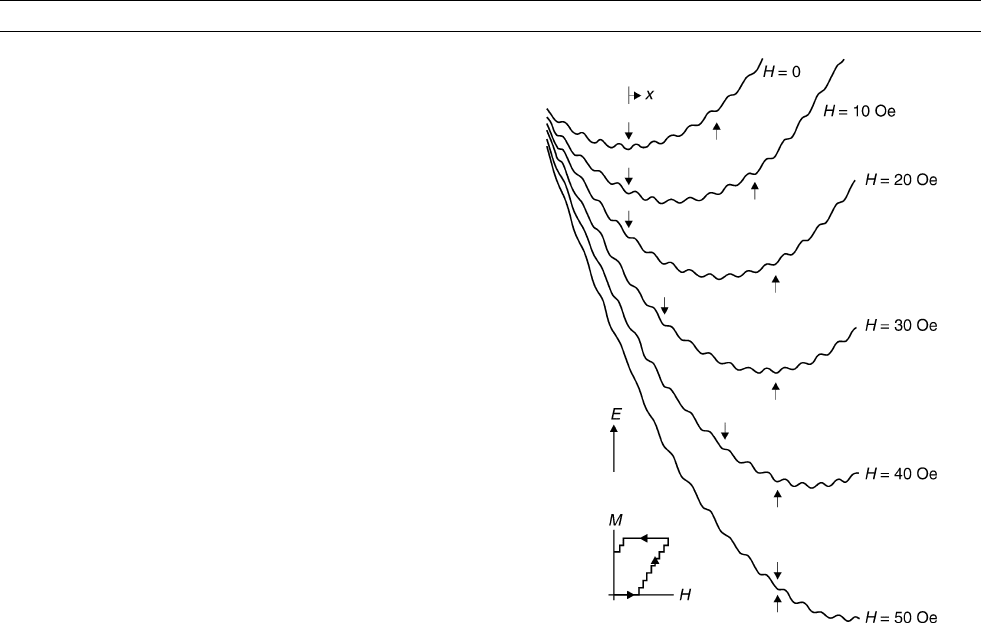
each pair of heating steps giving an independent estimate of H
A
. This
is the Thellier and Thellier (1959) method of paleointensity determina-
tion as modified by Coe (1967).
Multidomain TRM
In large grains containing many domain walls, TRM acquisition results
from several processes: domain wall pinning, domain nucleation or
denucleation, and nucleation failure. A multidomain grain contains
crystal imperfections such as inclusions, voids, and line defects such
as dislocations, all of which create surrounding stress fields. These
defects tend to pin domain walls. Voids and inclusions reduce the
volume of a wall and create magnetic poles, affecting both the wall
energy and demagnetizing energy. Dislocations pin walls by the mag-
netoelastic interaction between their stress fields and the spins in the
wall, which are rotated out of easy axes (Özdemir and Dunlop, 1997).
Pinned domain walls can be thermally activated just as SD moments
can. Wall displacements in response to a weak field applied at high
temperatures, like reversals of SD grains, can be frozen in by cooling
to room temperature, resulting in TRM. The Néel (1955), Everitt
(1962), and Schmidt (1973) multidomain TRM theories consider the
wall-defect interaction and the field dependence of the blocking tem-
perature. These theories follow Néel (1949) SD theory fairly closely
except that V becomes the volume of one Barkhausen jump of a
domain wall and H
K
becomes the critical field for such a Barkhausen
jump.
McClelland and Sugiura (1987) observed that during cooling below
the blocking range, after H had been zeroed, multidomain partial
TRM did not remain constant but decreased in real terms, i.e., M(T)/
M
S
(T). This observation compromises the concept of the blocking
temperature, because evidently, magnetization can partially relax dur-
ing cooling below T
B
. Later Shcherbakov et al. (1993) developed a
kinetic model that invokes nucleation or denucleation of domain walls
as a way of explaining changes in M(T ) below T
B
.
The only direct observations of domain nucleation during zero-field
warming or cooling are by Heider et al. (1988) and Ambatiello et al.
(1999) for magnetite and by Metcalf and Fuller (1987) and Halgedahl
and Fuller (1983) for titanomagnetite. In each case, any changes in the
number or widths of domains occurred either close to T
C
or in a range
of T where anisotropy changes rapidly, just above room temperature in
magnetite. In intermediate T ranges, where most observations of partial
TRM relaxation have been made, there is no evidence for nucleation.
A related phenomenon is nucleation failure. Titanomagnetite grains
field-cooled from T
C
sometimes nucleate fewer than the equilibrium
number of domain walls, and occasionally none at all (Halgedahl
and Fuller, 1980). The latter structure is of particular interest because
single-domain TRM is so intense that a small fraction of such grains
in metastable SD states could account for multidomain TRM. In parti-
cular, the size dependence of TRM in grains larger than SD size is then
explicable.
There are fundamental differences between SD and most MD TRM
models. The internal demagnetizing field H
D
¼ –NM favors a config-
uration of domain walls with minimum net moment. Loosely pinned
domain walls may undergo a series of Barkhausen jumps during heat-
ing and cooling. Therefore, there is no single blocking temperature for
a given domain wall or for a grain containing many walls since a jump
by one wall alters the internal field at the location of every other wall.
This is an alternative way of explaining TRM relaxation below T
B
.
Ne
´
el and Schmidt two-domain TRM theories
Néel’s (1955) 2D theory is based on the temperature dependence of
the wall-defect interaction and the wall displacement driven by the
internal demagnetizing field H
D
¼N M where M is the local magne-
tization vector. A domain wall, which has been displaced by H, will
reequilibrate its position at each new temperature during cooling under
the influences of H
D
and of local potential wells created by interaction
between the domain walls and lattice defects (Dunlop and Özdemir,
1997). The pinning strength is measured by the microcoercivity H
C
and determined by the barrier height between adjacent local energy
minimums (LEMs). Figure M131 shows the total energy in a two-
domain grain with many identical wall energy (E
W
) barriers, each with
the same coercivity H
C
for positive and negative jumps. The central
position of the wall is favored by the parabolic energy well due to the
demagnetizing energy E
D
. As the applied H increases, the parabolas
are tilted to the right by the field energy E
H
and the wall jumps from
one LEM to another in a series of Barkhausen jumps. Repeated jumps
of the wall generate the ascending part of the hysteresis loop, which
has a slope 1/N. The barriers to wall motion are not symmetric in
increasing and decreasing H.AsH decreases, the wall is pinned in a dif-
ferent set of LEMs and generates a descending loop with the same slope
1/N. When H becomes zero, the grain is left with a displaced wall and a
net moment, which is an isothermal remanent magnetization.
As the temperature decreases, the demagnetizing field and the bar-
riers between wells grow. At the blocking temperature T
B
, the potential
barriers E
W
begin to grow more rapidly than the demagnetizing field
H
D
pushing the wall back toward the demagnetized state and the wall
is trapped. TRM is frozen in. The basic result of Néel’s 2D theory is
that
M
TRM
¼ 2H
1=2
H
1=2
C
=N: (Eq. 6)
Equation (6) predicts absolute TRM intensity at room temperature.
The TRM is blocked by the growth of energy barriers to wall motion
Figure M131 Total energy, E
W
þ E
D
þ E
H
, as a function of wall
displacement x for various fields (after Schmidt, 1973).
Downward arrows show successive local energy minima in
which the wall is trapped as H increases from 0 to 50 Oe. Upward
arrows indicate minima where the wall is pinned as H decreases
from 50 to 0 Oe. The wall occupies different minima in increasing
and decreasing fields of the same strength, giving rise to magnetic
hysteresis and remanence.
MAGNETIZATION, THERMOREMANENT 613
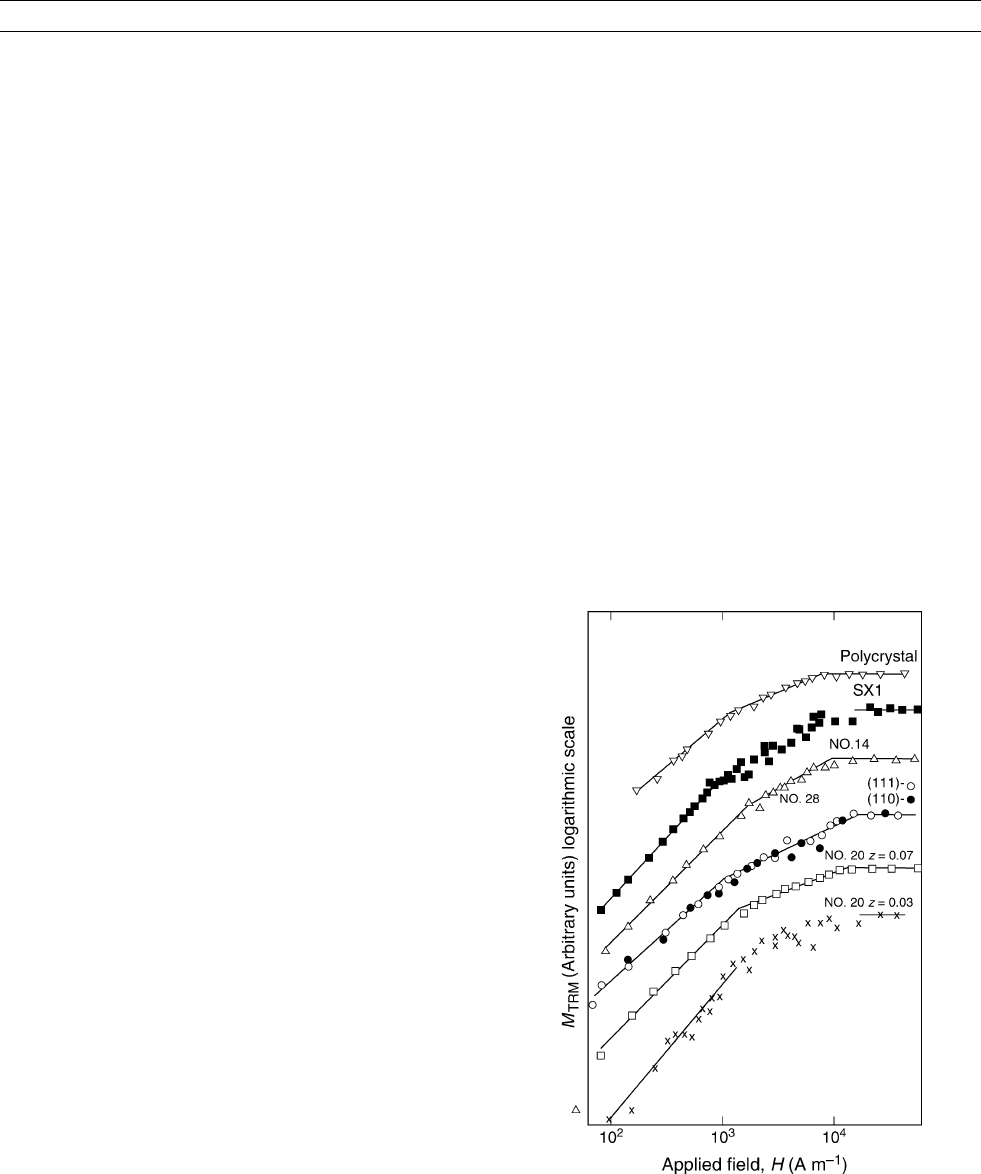
and thermal fluctuations are ignored. This is referred to as field-
blocked TRM.
Néel (1955) pointed out that field blocking of TRM occurs very
close to T
C
if H is small. At such high temperatures, thermal fluctua-
tions can unpin a domain wall below its blocking temperature T
B
. Néel
introduced a thermal fluctuation field H
F
such that a wall cannot be
blocked until
H
C
ðT
B
Þ¼H
F
; (Eq. 7)
where H
C
(T
B
) is the thermal fluctuation blocking temperature. TRM
intensity in the presence of thermal fluctuations is given by
M
TRM
¼ H
1=2
F
H
1=2
C
H=N : (Eq. 8)
Thermally blocked TRM should be proportional to H as observed
experimentally for small fields.
Schmidt’s (1973) MD model is based on the temperature varia-
tion of total energy in a two-domain grain with a single wall (Figure
M131). The model has the same physical basis as Néel’s 2D theory,
but the coercivity appears only as a derived quantity. The total
energy has contributions due to the interactions between the domain
wall and the applied field, the demagnetizing field, and lattice
defects. The temperature dependence of wall-defect interaction is con-
tained in a term m
p
, where m is the reduced domain magnetization
m(T) ¼ M/M
S
(T). The index p takes a value between 2 and 10
depending on the relative importance of magnetostriction or magne-
tocrystalline anisotropy in the wall pinning. The basic results of the
Schmidt model are that
H
C
ðTÞ/mðTÞ
p1
; (Eq. 9)
M
TRM
/ H
11=ðp1Þ
; (Eq. 10)
M
TRM
/ H
1=ðp1Þ
C
: (Eq. 11)
These are identical to Néel’s predictions (Eq. (6)) when p ¼ 3.
Stacey multidomain TRM theory
Stacey (1958) considered the blocking temperature T
B
to be indepen-
dent of the applied field and neglected the interaction between the
domain wall and lattice defects. At high temperatures, T
B
< T < T
C
,
the walls are highly mobile and take up positions in which the internal
field H
I
¼ H NM is zero. Above T
B
, the magnetization is given by
M ¼ H/N. During cooling below T
B
, the walls’ displacements are fro-
zen, so that M changes only by the reversible increase in M
S
(T ). At
room temperature, the TRM is given by
M
TRM
¼ HM
S
=½NM
SB
ð1 þ N w
0
Þ; (Eq. 12)
where w
0
is the initial volume susceptibility. Equation (12) seemingly
predicts the linear dependence of TRM on the applied field observed
experimentally for weak fields. In reality, as Néel (1955) showed,
blocking temperature T
B
is itself dependent on H. TRM as given by
Eq. (12) actually varies approximately as H
1/2
, a dependence observed
experimentally only when H > 1 mT.
Fabian phenomenological TRM model
Fabian (2000) has proposed a phenomenological approach in which a
sample is described in terms of a distribution function w(T
B
, T
UB
). This
formulation establishes no direct link between (T
B
, T
UB
) and physical
properties like grain size and coercivity, but recognizes that for
MD grains T
B
6¼ T
UB
in general, i.e., Thellier reciprocity does not
hold. With this simple approach, it is possible to explain many
observed properties of multidomain partial TRMs and to justify the
kinematic equation for partial TRM relaxation during cooling or heat-
ing (Shcherbakov et al., 1993). Although not a theory of TRM acqui-
sition in the fundamental sense, the Fabian model is useful in
describing and connecting a body of experimental data and making
predictions about the TRM properties of a particular sample based
on its measured w(T
B
, T
UB
).
Experimental multidomain TRM
There are relatively few testable predictions of multidomain TRM the-
ories. The prediction that TRM intensity should increase with increas-
ing H
C
(Eqs. (6), (8), (11)) was verified in a general way in Néel’s
original paper and the test has not been improved upon since. The pre-
dicted dependence on applied field H has received more attention.
Tucker and O’Reilly (1980) showed that in the low-field region (H
1kAm
–1
, where 80 A m
–1
1Oe¼ 0.1 mT), the TRM of large
titanomagnetite crystals, as predicted by Eq. (8), was more or less pro-
portional to H (Figure M132). For intermediate field strengths, the
field dependence was as a power of H < 1(Eqs. (6) or (10)), and
saturation occurred around 10 kA m
–1
. Similar results for magnetite
and magnetite-bearing rocks were reported by Dunlop and Wadding-
ton (1975) and for pyrrhotite by Menyeh and O’Reilly (1998).
Figure M132 TRM acquisition curves for millimeter-size single
crystals of titanomagnetite with composition Fe
2.4
Ti
0.6
O
4
(TM60),
plotted bilogarithmically (after Tucker and O’Reilly, 1980). The
experimental data have been fitted by a series of linear segments
corresponding to power law dependences of TRM on applied
field. TRM intensity is proportional to H for fields below about
2 mT, then increases approximately as H
1/2
until it saturates at
the value M
RS
¼ H/N, in agreement with Ne
´
el’s (1955) theory
of TRM due to domain wall displacement limited by
self-demagnetization.
614 MAGNETIZATION, THERMOREMANENT
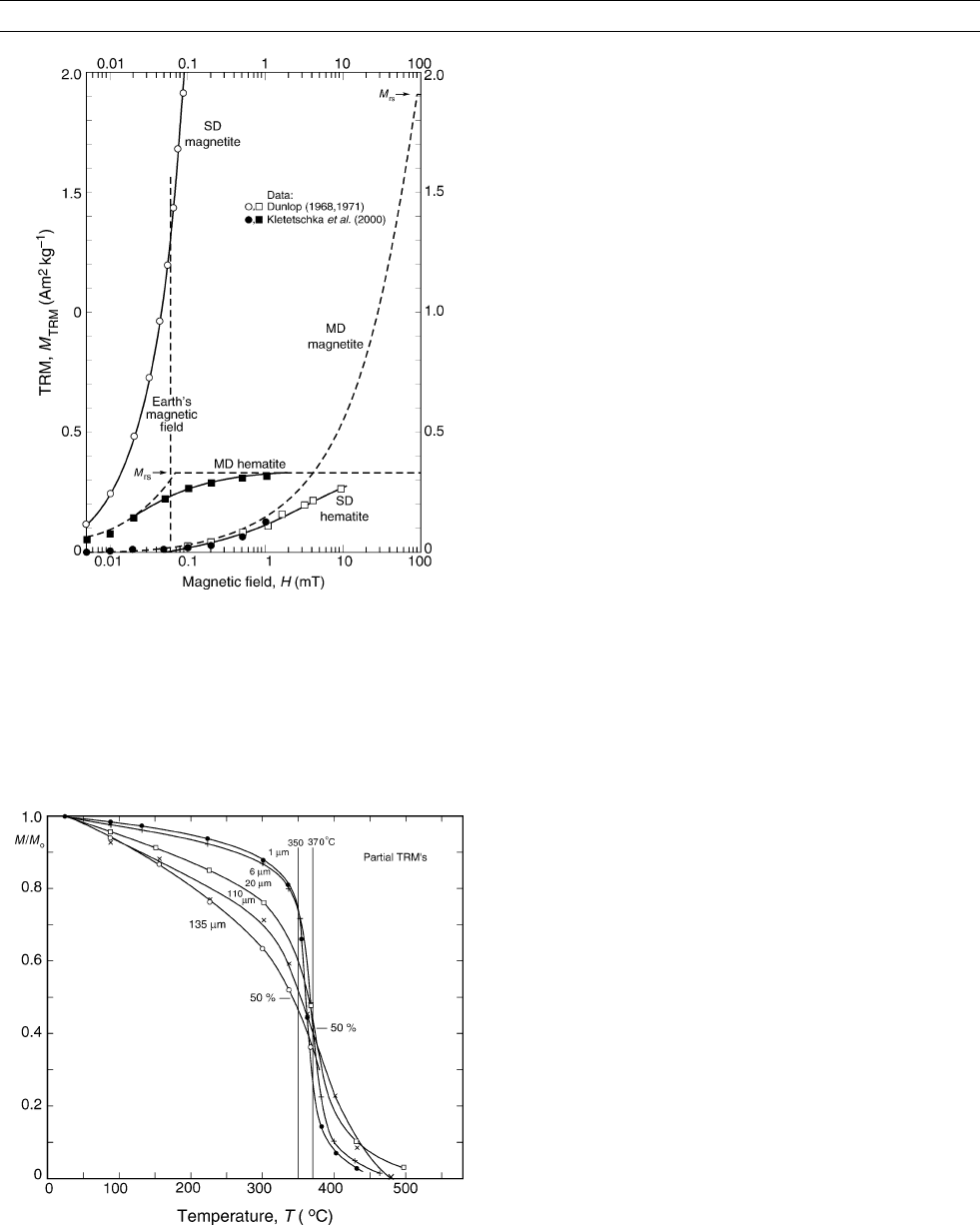
An interesting sidelight on multidomain TRM behavior is the fact
that for H of the order of the Earth’s magnetic field, weakly magnetic
hematite (M
S
2 kA/m) in a multidomain state has a much stronger
TRM than MD magnetite (M
S
¼ 480 kA m
–1
) or SD hematite (Figure
M133). The reason is that the weak M
S
of hematite results in a negli-
gible demagnetizing field H
D
, so that even a small H is sufficient to
drive walls to their limiting positions and saturate the TRM (Dunlop
and Kletetschka, 2001). MD magnetite does not approach saturation
TRM except in fields 3 orders of magnitude larger because of its cor-
respondingly greater H
D
.
The model of Fabian (2000) was a response to recent experimental
work on multidomain partial TRMs. The thermal demagnetization
data of Figure M134 are one example. Partial TRMs produced by
applying H over a narrow blocking interval T
B
¼ 370–350
C are
demagnetized over increasingly broad intervals of unblocking tem-
perature T
UB
as the grain size increases. While partial TRMs of
1 and 6 mm magnetites demagnetized mainly over the original T
B
interval, partial TRMs of 110 and 135 mm grains demagnetized
almost entirely outside the 370
C–350
C interval. This almost total
violation of reciprocity led Fabian (2000) to treat T
B
and T
UB
as
independent variables.
Özden Özdemir
Bibliography
Ambatiello, A., Fabian, K., and Hoffmann, V., 1999. Magnetic domain
structure of multidomain magnetite as a function of temperature:
observations by Kerr microscopy. Physics of the Earth and Plane-
tary Interiors, 112:55–80.
Coe, R.S., 1967. The determination of paleointensities of the earth’s
magnetic field with emphasis on mechanisms which could cause
non-ideal behaviour in Thellier’s method. Journal of Geomagnet-
ism and Geoelectricity, 19: 157–179.
Clauter, D.A., and Schmidt, V.A., 1981. Shifts in blocking temperature
spectra for magnetite powders as a function of grain size and
applied magnetic field. Physics of the Earth and Planetary Inter-
iors, 26:81–92.
Day, D., 1977. TRM and its variation with grain size. Journal of Geo-
magnetism and Geoelectricity, 29: 233–265.
Dodson, M.H., and McClelland-Brown, E., 1980. Magnetic blocking
temperatures of single-domain grains during slow cooling. Journal
of Geophysical Research, 85: 2625 –2637.
Dunlop, D.J., 1973. Thermoremanent magnetization in submicroscopic
magnetite. Journal of Geophysical Research, 78: 7602–7613.
Dunlop, D.J., and Argyle, K.S., 1997. Thermoremanence, anhysteretic
remanence and susceptibility of submicron magnetites: nonlinear
field dependence and variation with grain size. Journal of Geophy-
sical Research, 102: 20199–20210.
Dunlop, D.J., and Kletetschka, G., 2001. Multidomain hematite: a
source of planetary magnetic anomalies? Geophysical Research
Letters, 28: 3345–3348.
Dunlop, D.J., and Özdemir, Ö., 1997. Rock Magnetism: Fundamentals
and Frontiers. Cambridge and New York: Cambridge University
Press.
Dunlop, D.J., and Özdemir, Ö., 2001. Beyond Néel theories: thermal
demagnetization of narrow-band partial thermoremanent mag-
netizations. Physics of the Earth and Planetary Interiors, 126:
43–57.
Dunlop, D.J., and Waddington, E.D., 1975. The field dependence of
thermoremanent magnetization in igneous rocks. Earth and Plane-
tary Science Letters, 25:11–25.
Dunlop, D.J., and West, G.F., 1969. An experimental evaluation of sin-
gle domain theories. Reviews of Geophysics
, 7: 709–757.
Everitt, C.W.F., 1961. Thermoremanent magnetization. I. Experiments
on single domain grains. Philosophical Magazine, 6: 713–726.
Everitt, C.W.F., 1962. Thermoremanent magnetization. III. Theory of
multidomain grains. Philosophical Magazine, 7: 599–616.
Figure M134 Stepwise thermal demagnetization of partial TRMs
produced by a small field applied during cooling from 370 to
350
C in magnetites ranging from small PSD to MD size. About
50%–90% of the remanence unblocks at temperatures below or
above the PTRM blocking temperature range. Tailing of thermal
demagnetization curves is not confined to large MD grains but
is significant even for fairly small PSD grains (after Dunlop and
O
¨
zdemir, 2001).
Figure M133 Comparison of experimental (points and solid
curves) and theoretical (dashed curves) TRM values for SD and
MD hematites and magnetites (Dunlop and Kletetschka, 2001).
The contrast in TRM intensities for two minerals is due to the
internal demagnetizing field H
D
¼NM. At saturation,
H
D
200 mT for magnetite, but for hematite H
D
1 mT,
making it much easier for a small field like the Earth’s to push
the magnetic domain walls to their limiting positions.
MAGNETIZATION, THERMOREMANENT 615
